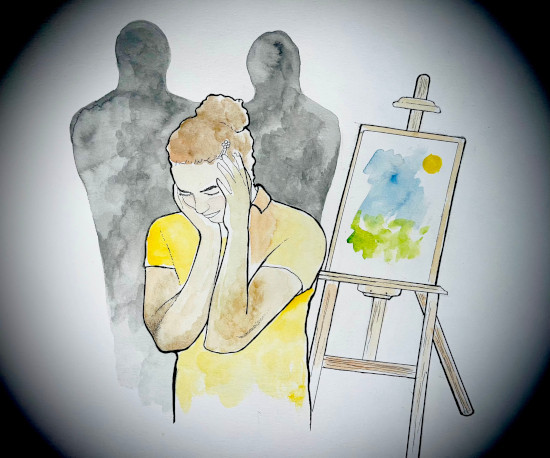Lessons from a writer’s block
Exploring the parallel of creativity and children’s need for safe space

Illustration by Gabrielle Funk
In the past five months, I found myself confined in a creative block, a period where the flow of new ideas seemed to have dried up entirely. It left me questioning if my once-thriving ability to write was just a seasonal phase or a lost genius.
Now, looking back, I’ve come to realize that creativity, similar to a child in need of a stable and nurturing environment, requires specific conditions for growth.
Much like a child yearns for a stable and nurturing environment to thrive, creativity, too, flourishes when granted the essential conditions for its growth and expression.
Children, in their formative years, require safety, encouragement and the freedom to explore their potential without the constraints of fear or extreme pressure. This foundation provides them with the security to experiment, learn and develop into confident individuals.
Similarly, creativity, as the imaginative essence within, requires a supportive atmosphere – a mental sanctuary where inspiration can take root and ideas can evolve organically.
During moments of positivity and mental clarity, creativity flourishes, much like a child who thrives when their parents are in a good mood. In these instances, the child can relax, showcase their best attributes, excel in endeavors, achieve high grades and maintain a healthy existence.
However, when the parents become overwhelmed by the external stressors of life, the child can start to falter. The uncertainty of the environment can prompt the child to turn to survival mode, hindering their potential for growth.
The child often retreats, hiding in a closet, attempting to avoid confrontation with the unpredictable or chaotic parents. Similarly, the weight of external pressures infiltrates the creative space. In this state, the creative essence merely exists, often hiding in the recesses of the mind, avoiding the chaos of the external world.
Reflecting on this analogy, I recognized that I had become the dysfunctional parent to my creativity, failing to provide it with the necessary time and a nurturing environment. I had allowed the blurred lines between work and personal life to affect my creative wellbeing. Much like a parent bringing work stress home, I projected my anxieties onto my creative self, causing it to falter and lose its vibrancy.
By acknowledging this insight, I am committed to doing better. I understand the importance of drawing a clear line between life and work. Without this distinction, I risk drowning in perpetual guilt, fearing that I may have lost the child inside me who once reveled in the joy of writing.
Just as a child needs safety, encouragement and the freedom to explore its potential without fear, creativity requires the same. It necessitates a conscious effort to separate the burdens of everyday life from the sacred space where imaginative thoughts can take root.
I am optimistic that, by creating this balance, I can provide my creative self with the stability it needs to flourish once more. After all, just like a child in need of a stable environment, my creativity deserves a chance to grow, learn and express itself freely.
Muskan Vhora is currently pursuing her second year of a BA in creative writing. Her constants are coffee and A. R. Rahman’s music.
Published in Volume 78, Number 13 of The Uniter (January 10, 2024)







